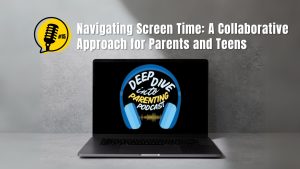Managing children’s screen time in today’s digital age is no small feat. Drawing from decades of experience in law enforcement and behavioral threat assessment, Clayton Cranford offers practical strategies in his book, Screen Time Standoff: Negotiation Skills to Unplug Your Kid. This guide empowers parents with communication tools to foster collaboration and establish healthy digital habits. Here, we explore some of his key methods to help parents navigate this complex issue.
The Foundation of Effective Negotiation
1. Build Rapport Before Rules
Building rapport with your child is the cornerstone of effective negotiation because it establishes trust and opens the door for meaningful dialogue. When children feel understood and valued, they are more likely to engage in conversations about screen time boundaries without resistance. This foundational step not only strengthens your relationship but also lays the groundwork for collaborative problem-solving.
-
Understand Their Digital World: Show genuine interest in what your child enjoys online. Ask questions like, “What’s your favorite part of gaming?” or “What’s exciting about TikTok trends?”
-
Avoid Immediate Criticism: Judgmental statements can shut down dialogue. Instead, listen actively to their responses.
2. Meet Them Where They Are
Rather than imposing rules unilaterally, engage in discussions that respect your child’s perspective. By understanding their motivations and challenges, you can frame screen time boundaries as a collaborative effort.
Techniques for Effective Communication
Technique #1: Use Open-Ended Questions
Open-ended questions encourage dialogue and reduce defensiveness because they invite teenagers to express their thoughts and feelings without the pressure of giving a "right" answer. This approach helps build trust and creates a safe space where teens feel their opinions are valued, fostering more meaningful and productive conversations.
Examples of Open-Ended Questions
-
Gaming/Social Media: “What do you like most about gaming?”
-
Sensitive Topics: “How do you feel when you don’t get a lot of likes on a post?”
-
General Interests: “What excites you about the latest tech trends?”
By focusing on curiosity and empathy, these questions create an environment where children feel heard and understood.
Technique #2: Reflective Listening
Reflective listening involves acknowledging and validating your child’s emotions. For example, when a child says, “I feel like no one listens to me,” a parent might respond, “It sounds like you feel ignored and unimportant.” Similarly, if your teenager shares, “I hate how I look in photos,” you could reflect back with, “You’re feeling self-conscious about your appearance, and it’s really upsetting you.” These examples demonstrate how reflective listening can help children feel understood and supported, fostering a deeper emotional connection.
Example of Reflective Listening
-
Child: “Everyone at school is better at gaming than me.”
-
Parent: “It sounds like you’re feeling frustrated and left out.”
This validation builds trust, encouraging your child to open up further and making it easier to guide the conversation.
Technique #3: Expressing Confusion
When your child’s logic doesn’t align with their goals, expressing confusion can prompt reflection without creating conflict.
Example of Expressing Confusion
-
Parent: “I’m confused. You said you want good grades, but gaming late at night seems to be affecting your school performance. Can you help me understand?”
This nonjudgmental approach shifts the focus to their reasoning, encouraging them to identify inconsistencies in their behavior.
Addressing Objections to Screen Time Limits
Understanding the Appeal of Screens
To effectively manage screen time, it’s essential to understand why screens are so engaging. Screens captivate users by offering instant gratification through rewards, such as unlocking achievements in video games or receiving likes on social media. They also provide a structured environment with clear goals, fostering a sense of accomplishment. Moreover, the interactive nature of digital platforms often delivers a sense of agency and control, which can be particularly appealing to teenagers who may feel less empowered in other areas of their lives. Recognizing these psychological drivers helps parents address screen time habits with empathy and effectiveness.







